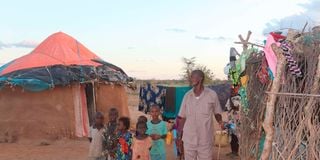The growing reality of climate refugees

Wario Godana with his children who no longer go to school as the only primary school in the area closed down after floods marooned the area.
What you need to know:
- Climate change is not a sudden eviction notice for millions of displaced people.
- It is a slow and relentless erosion, chipping away livelihoods and forcing difficult choices.
In 2022 alone, more than 7.4 million people across Africa were displaced due to climate shocks, adding to existing conflicts and instability. This is according to the International Organization for Migration (IOM).
This trend reflects a growing reality – climate change is a powerful driver of migration across the continent. Here in Kenya, the IOM Kenya Report states that more families are now forced to abandon their homes for sustenance. The country has witnessed the devastating effects of consecutive droughts, with the situation in the Horn of Africa leaving millions of people facing food insecurity.
Such statistics highlight the complex relationship between climate change and migration.
Climate change is not a sudden eviction notice for millions of displaced people. It is a slow and relentless erosion, chipping away livelihoods and forcing difficult choices.
Environmental changes often intertwine with social and economic vulnerabilities to brew the perfect storm for displacement. For example, a community already struggling with poverty and limited resources instantly moves in search of a better life when droughts or floods come knocking.
Rising sea levels
Coastal communities, especially in low-lying areas, face a double threat. Saltwater intrusion contaminates their freshwater while rising sea levels gobble their valuable land. This has become particularly concerning for island nations and densely populated coastal regions, where entire communities face displacement.
Desertification
As rainfall patterns change and temperatures climb, arable land succumbs to desertification. This phenomenal transformation of land into desert affects pastoral communities relying on grazing land for sustenance. Their traditional way of life is disrupted, forcing them to migrate to find new pastures.
Extreme weather events
Droughts, floods and storms are becoming more frequent and intense. These extreme weather events can devastate entire regions, destroying homes, crops and infrastructure. The recent heavy rains in Lagos, Nigeria, which flooded over 150 households in two days and forced evacuation, are a stark reminder of this threat.
The journey for climate migrants is far from easy. They face many challenges that can make starting anew incredibly difficult, starting with the lack of opportunities in unfamiliar areas. Migrants often arrive with limited resources and skills that may not be readily applicable in their new surroundings.
This can lead to a struggle to find work and establish a stable life, pushing them towards poverty and even exploitation. Additionally, these influxes can create social tensions with host communities, especially if they relocate to an area struggling with limited resources.
A huge number of migrants can strain their receiving area and overwhelm local resources like water, sanitation and healthcare. This can lead to a breakdown in infrastructure as these communities need help to meet the needs of existing residents and newcomers.
The lack of legal recognition for climate migrants adds another layer of difficulty. Current international refugee law frameworks often don't consider climate displacement a legitimate reason for seeking refuge. This leaves migrants without legal protection and hinders their access to basic rights like healthcare and education. Climate-induced migration won't disappear on its own. However, some solutions can help us navigate its complexity. We can apply workable solutions by understanding the drivers of climate migration and the challenges displaced communities face.
A key approach lies in climate adaptation strategies. Investing in drought-resistant crops, water conservation techniques and early warning systems for extreme weather events can empower communities to remain on their land longer. For example, farmers who adopt drought-resistant crops have more reliable harvests, hence little need to migrate.
International cooperation is crucial for developing regional frameworks that facilitate safe passage for cases of inevitable displacement. This includes granting migrants access to necessities like food and shelter along the migration route. These frameworks can also support the integration of migrants into their new communities, easing social tensions. They could play a huge role in addressing the root causes of displacement to prevent it from happening in the first place.
Supporting displaced communities helps them rebuild their lives. International support for local governments and NGOs working on the ground helps provide resources to meet basic needs like food, water and healthcare. Good support facilitates a smoother integration process, strengthening displaced communities and allowing them to contribute to their new homes.




